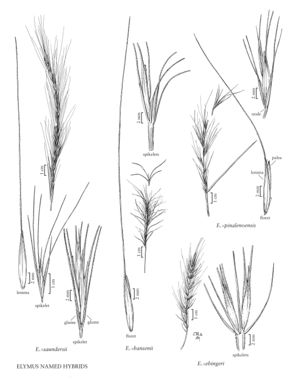Elymus ×pinalenoensis
Plants cespitose, not rhizomatous. Culms 60-90 cm tall, about 2 mm thick. Leaves somewhat basally concentrated; sheaths smooth or scabridulous; auricles to 1.5 mm; ligules 0.5-0.7 mm, rounded; blades 2-2.5 mm wide, those of the basal leaves 7-15 cm long, those of the flag leaves 2-7 cm long, abaxial surfaces smooth or scabridulous, glabrous or sparsely hairy basally, veins not evident, adaxial surfaces scabrous, sometimes with scattered hairs, veins prominently and equally ribbed. Spikes 8-14 cm long, about 5 cm wide including the awns, about 1 cm wide excluding the awns, nodding, lower nodes with 1-2 spikelets, upper nodes with 1 spikelet; internodes about 10 mm; disarticulation in the rachises and beneath each floret. Glumes 22-31 mm including the awns, glume bodies 5-10 mm, midvein evident, scabrous, awns 17-26 mm, divergent, scabrous; lemmas 11-13 mm, smooth, awns 20-40 mm, divergent, sometimes strongly divergent; anthers about 2 mm long, 1-1.5 mm thick.
Discussion
Elymus ×pinalenoensis consists of hybrids between E. elymoides subsp. brevifolius (p. 319) and E. arizonicus (p. 329) (Pyrah 1983). It has been found in the Pinaleno and Santa Catalina mountains of Graham County, Arizona, in areas disturbed by logging, road building, summer home development, and recreation.
Elymus ×pinalenoensis is an Elymus named hybrid
Elymus is notorious for its ability to hybridize. Most of its interspecific hybrids are partially fertile, permitting introgression between the parents. The descriptions provided below are restricted to the named interspecific hybrids. They should be treated with caution and some skepticism; some are based solely on the type specimen, because little other reliably identified material was available. Moreover, as the descriptions of the non-hybrid species indicate, many other interspecific hybrids exist.
The parentage of all hybrids is best determined in the field. Perennial hybrids, such as those in Elymus, can persist in an area after one or both parents have died out, but the simplest assumption is that both are present. Interspecific hybrids of Elymus that have disarticulating rachises presumably have E. elymoides or E. multisetus as one of their parents.
Selected References
None.
Lower Taxa
"decumbent" is not a number.
